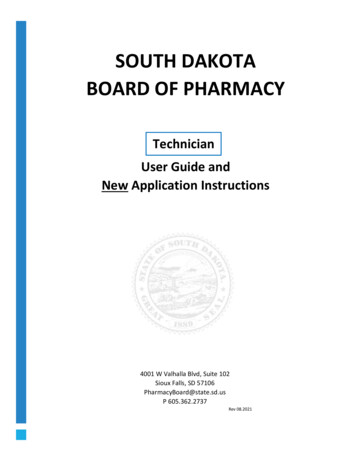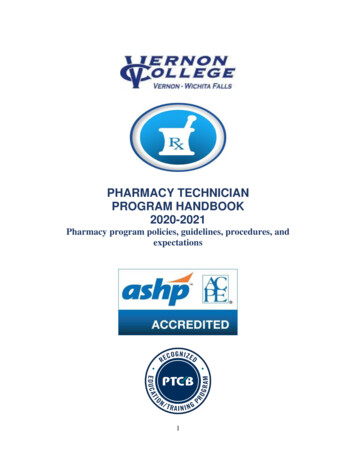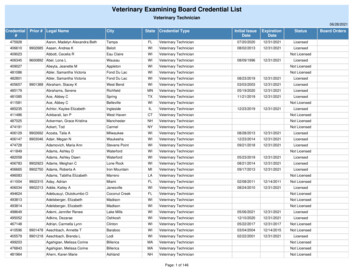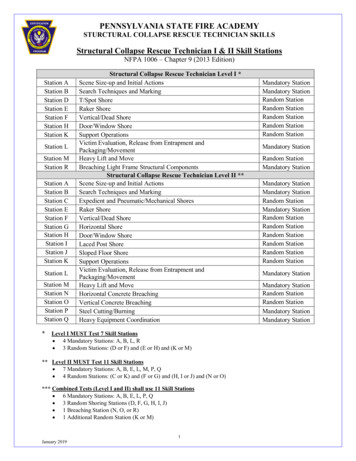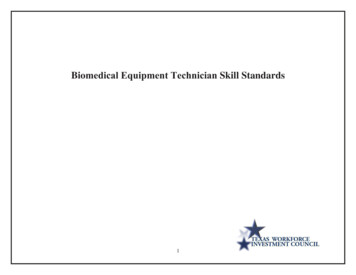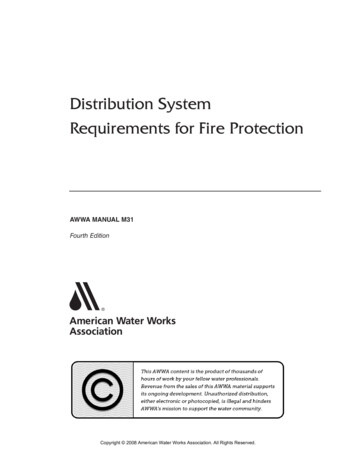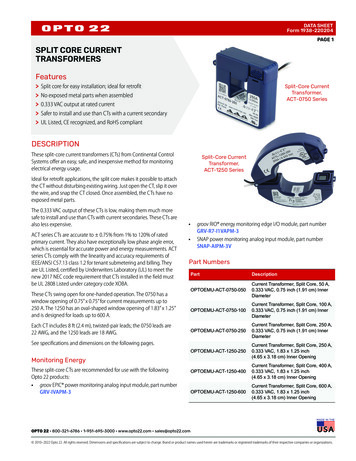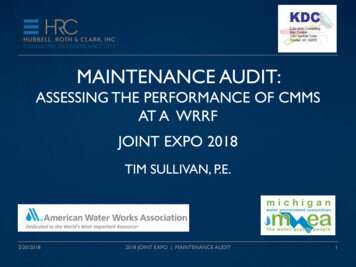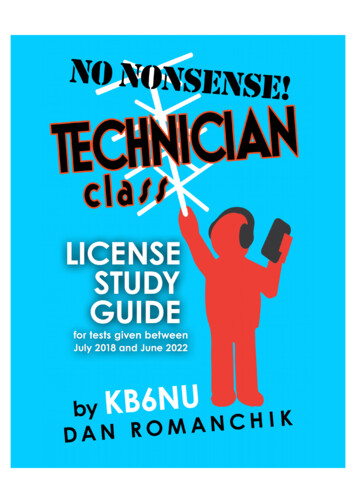
Transcription
No Nonsense Technician ClassLicense Study Guidefor tests given between July 2018 and June 2022Dan Romanchik KB6NUCopyright 2018 Daniel M. RomanchikAll rights reserved. No part of this publication may be reproduced, stored in a retrieval system, ortransmitted in any form or by any means, electronic, mechanical, recording or otherwise, without theprior written permission of the author.Revision 1.1, 10/31/2018
Table of ContentsWhat is amateur (ham) radio?.1How do you get into amateur radio?.1How much does it cost?.1Where do I take the test?.2Can I really learn how to be an amateur radio operator from a study guide like this?.2How do I use this study guide?.2Good luck and have fun.3Electrical principles.4Units and terms: current, voltage, and resistance; alternating and direct current;conductors and insulators.4Ohm’s Law: formulas and usage.7Series and parallel circuits.9DC power.11Math for electronics and conversion of electrical units.12Decibels.14Electronic components and circuit diagrams.15Resistors, capacitors and capacitance, inductors and inductance, batteries.15Semiconductors: basic principles and applications of solid state devices, diodes andtransistors.17Circuit diagrams, schematic symbols, component functions.19Other components.23Radio wave characteristics.24Frequency, wavelength, and the electromagnetic spectrum.24Properties of radio waves and propagation modes.27HF Propagation.31Antennas and feed lines.33Antenna types and antenna polarization.33Feed lines and connectors.36
Standing wave ratio and antenna measurements.39Amateur radio signals.42Modulation modes and signal bandwidth.42Digital modes: packet, PSK31.44Electrical safety.47Power circuits and hazards, hazardous voltages, fuses and circuit breakers, grounding,and battery safety.47Antenna and tower safety.49RF hazards and radiation exposure.51Amateur radio practices and station setup.53Station setup: connecting microphones, reducing unwanted emissions, power sources,connecting a computer, RF grounding, connecting digital equipment.53Operating controls: tuning, use of filters, squelch function, AGC, repeater offset,memory channels.56Station equipment.58Receivers, transmitters, transceivers, modulation, transverters, low power and weaksignal operation, transmit and receive amplifiers.58Common transmitter and receiver problems: symptoms of overload and overdrive;distortion; causes of interference; interference and consumer electronics; part 15devices; over-modulation; RF feedback; off frequency signals.60Basic repair and testing: soldering; using basic test instruments; connecting a voltmeter,ammeter, or ohmmeter.63Operating Procedures.65FM Operation.65HF Operation.68Public service and emergency communications.70Amateur satellite operation.72Operating activities.75Rules and regulations.77Purpose and permissible use of the Amateur Radio Service, operator/primary stationlicense grant; basic terms used in FCC rules; interference; RACES rules; phonetics;Frequency Coordinator.77
bands; spectrum sharing; transmissions near band edges; contacting the InternationalSpace Station; power output.79Operator licensing: operator classes; sequential and vanity call sign systems;international communications; reciprocal operation; places where the Amateur RadioService is regulated by the FCC; name and address on FCC license database; licenseterm; renewal; grace period.81Authorized and prohibited transmission: communications with other countries; music;exchange of information with other services; indecent language; compensation for useof station; retransmission of other amateur signals; codes and ciphers; sale ofequipment; unidentified transmissions; one-way transmission.84Control operator and control types: control operator required; eligibility; designation ofcontrol operator; privileges and duties; control point; local, automatic and remotecontrol; location of control operator.86Station identification, repeaters, third-party communications, FCC inspection.88Glossary.90About the Author.92
What is amateur (ham) radio?Amateur radio, also known as ham radio, is a hobby enjoyed by hundreds of thousands of Americansand millions around the world. Tey enjoy communicating with one another via two-way radios andexperimenting with antennas and electronic circuits.All kinds of people are amateur radio operators, also known as “hams.” Hams are young, old, men,women, boys and girls. Kids as young as seven years old have gotten amateur radio licenses, and manyhams are active into their eighties and beyond. You never know who you'll run into on the amateurradio bands: young and old, teachers and students, engineers and scientists, doctors and nurses,mechanics and technicians, kings and entertainers.For example, did you know that most of the astronauts sent up to the International Space Station (ISS)in the last fve to ten years have been licensed radio amateurs? Tey use the amateur radio station onboard the ISS to communicate with school groups all over the world as they are fying over.How do you get into amateur radio?With just a little study, you can learn all you need to know to get a Technician Class license, which isthe license class designed for beginners. To get a Technician Class license, you must take a test with 35multiple-choice questions and answer 26 questions correctly. Te test covers basic regulations, operatingpractices, and electrical and electronics theory.Knowing Morse Code is no longer required to get this license, nor any class of license. Technician Classlicensees have all amateur radio privileges above 30 MHz, including the very popular 2-meter band.Technicians can also operate Morse Code (CW) on portions of the 80m, 40m, 15m, and 10m bands,and voice and digital modes on portions of the 10m band.Tere are two other license classes: the eeneral Class license and the Amateur xxtra Class license. Toget a eeneral Class license, you must pass another 35-question test; the Amateur xxtra Class test has 50questions. Te tests are progressively more difcult.eeneral Class licensees get phone and digital mode privileges on portions of the 160m, 80m, 60m,40m, 20m, 17m, 15m, 12m, and 10m bands. Tey can also operate CW and digital modes on the 30mband. Amateur xxtra licensees have all amateur privileges.How much does it cost?Basic study materials, such as this study guide, can be had for free, and the license exam fee will be 15or less. Once you have your frst license, most hams fnd it best to start with simple equipment andgrow over time. A handheld VHF FM transceiver can be purchased for less than 100 new, andexcellent used equipment is often available at low prices. All things considered, the cost to get the frstlicense and radio should be less than 200.1
Where do I take the test?Amateur radio license examinations are given by Volunteer xxaminers, or Vxs. Vxs are licensed radioamateurs who have been trained to administer amateur radio tests. To fnd out when the Vxs in yourarea will be giving the test, go to the American Radio Relay League's (ARRL) icense-exam-session. Using that page, you will be able tosearch for test sessions that are close to you. If you do not have access to the Internet, you can phonethe ARRL at 860-594-0200.Can I really learn how to be an amateur radio operator from a studyguide like this?Yes and no. Tis manual will help you get your license, but getting your license is only the beginning.Tere is still much to learn, and to get the most out of amateur radio, you will have to continually learnnew things.Tis study guide will teach you the answers to the test questions, but will not give you a deepunderstanding of electronics, radio, or the rules and regulations. Tat will be up to you after you getyour license.I hope that, by helping you get your license, this guide will encourage you to become an active radioamateur and get on the air, participate in public service and emergency communications, join anamateur radio club, and experiment with radios, antennas, and circuits. Tese are the activities that willreally help you learn about radio in depth, and in the end, help you be confdent in your abilities as anamateur radio operator.How do I use this study guide?First, read through the study guide and then take some practice tests. Te characters in parentheses —(T5A05), for example—refer to the question number in the Technician Class xxam Question Pool.You will fnd the answers to questions in bold. You can take practice tests by going to the followingwebsites: AA9PW.com QRZ.com/hamtest/ eHam.net/exams/ (http://eham.net/exams/) Hamxxam.org (http://hamexam.org) HamStudy.org (http://hamstudy.org)Tere are also ham test apps for both iOS and Android tablets: iOS: Amateur Radio xxam Prep m- prep2
technician/id297951496?mt 8). 4.99 Ham Radio xxam (https://itunes.apple.com/us/app/ham-radio-exam- tech/id601991935?mt 8). FRxx. Android: Ham Radio Study (https://play.google.com/store/apps/details?id com.tango11.hamstudy) Ham Test Prep (https://play.google.com/store/apps/details?id com.iversoft.ham.test.prep&hl en)Many of the questions use acronyms with which you may be unfamiliar. In the glossary, you will fnddefnitions of those acronyms. Please refer to the glossary if you are unsure of the meaning of anacronym.Good luck and have funI hope that you fnd this study guide useful and that you’ll become a radio amateur. Remember thatgetting your license is just a start and that you will continue to learn new things.If you have any comments, questions, compliments or complaints, I want to hear from you. x-mail meat cwgeek@kb6nu.com. My goal is to continually refne and improve this study guide.Dan Romanchik KB6NU3
Electrical principlesUnits and terms: current, voltage, and resistance; alternating and directcurrent; conductors and insulatorsFigure 1 shows a simple electric circuit. It consists of a voltage source (in this case a battery, labeled x),a resistor (labeled R), and some wires to connect the battery to the resistor. When connected in thisway, the battery will cause a current (labeled I) to fow through the circuit.Figure 1. A simple electric circuitTe three basic parameters of this circuit are electromotive force (x), current (I), and resistance (R).xlectromotive force, or xMF, is the force that causes electrons to fow in a circuit. We use the letter xto denote electromotive force. xlectromotive force is measured in volts, and we use the letter V todenote volts.QUxSTION: What is the electrical term for the electromotive force (xMF) that causeselectron fow? (T5A05)ANSWxR: VoltageQUxSTION: What is the unit of electromotive force? (T5A11)ANSWxR: The veolt vQUxSTION: How much voltage does a mobile transceiver typically require? (T5A06)ANSWxR: About v12 veoltsCurrent is the fow of electrons in a circuit. In Figure 1, the letter I stands for current. Current fowsfrom the positive ( ) terminal of the voltage source through the circuit to the negative terminal of thevoltage source. Current is measured in amperes, and we use the letter A to stand for amperes.4
QUxSTION: What is the name for the fow of electrons in an electric circuit? (T5A03)ANSWxR: CurrentQUxSTION: xlectrical current is measured in which of the following units? (T5A01)ANSWxR: AmperesBecause the polarity of the battery voltage never changes, the current will fow in only one directionthrough the circuit. We call this direct current, or DC.QUxSTION: What is the name for a current that fows only in one direction? (T5A04)ANSWxR: Direct vcurrentBatteries supply direct current, or simply, DC.Resistance is the third parameter. As the name implies, resistance opposes the fow of electrons in acircuit. Te higher the resistance, the smaller the current. We use the letter R to stand for resistance.Resistance is measured in ohms, and we use the ereek letter omega ( Ω) to stand for ohms.Te type of current you get out of a wall socket is diferent from the current that you get from a battery.Unlike the battery, the polarity of the voltage changes from positive to negative and back to positive ona regular basis. In fact, it changes polarity 120 times per second. Tis means that the current changesdirection 120 times per second. Because of this, we call it alternating current, or AC.QUxSTION: What is the name for a current that reverses direction on a regular basis?(T5A09)ANSWxR: Alternating vcurrentOne of the most important parameters of an alternating current is its frequency. Te frequency of analternating current is the number of cycles per second, where a cycle is the time required for analternating current to go from 0 V to its most positive value, then negative to its most negative value,then positive to 0 V again.QUxSTION: What term describes the number of times per second that an alternatingcurrent makes a complete cycle? (T5A12)ANSWxR: FrequencyQUxSTION: What is the unit of frequency? (T5C05)ANSWxR: Hertz1 Hz is equal to one cycle per second. An alternating current reverses polarity twice per cycle, so thefrequency of the alternating current available from a wall socket is 60 Hz.5
Conductors are materials that conduct electrical current well or, in other words, have a low resistance.We use copper wires to connect a power supply to a radio because copper wires are good conductors.QUxSTION: Which of the following is a good electrical conductor? (T5A07)ANSWxR: CopperSilver is actually a better conductor than copper, but copper is a lot less expensive than silver. Often,you will see gold used as a conductor. Although gold is not as good a conductor as either copper orsilver, it doesn’t corrode like copper or silver. Tat makes it a good choice for switch or connectorcontacts.Many times we need a material that does not conduct current very well. We call these materialsinsulators, and insulators have a high resistance. Plastics and glass are commonly used insulators.QUxSTION: Which of the following is a good electrical insulator? (T5A08)ANSWxR: Glass6
Ohm’s Law: formulas and usageHams obey Ohm’s Law!Ohm’s Law is the relationship between voltage, current, and resistance in an electrical circuit. Whenyou know any two of these values, you can calculate the third.Te most basic equation for Ohm’s Law is x I R. In other words, when you know the currentfowing through a circuit and the resistance of the circuit, you can calculate the voltage across the circuitby multiplying these two values.QUxSTION: What formula is used to calculate voltage in a circuit? (T5D02)ANSWxR: Voltage v(E) vequals vcurrent v(I) vmultiplied vby vresistance v(R)Using simple algebra, you can derive the other two forms of this equation. Tese two equations let youcalculate the resistance in a circuit if you know the voltage and current or the current in a circuit if youknow the voltage and resistance.QUxSTION: What formula is used to calculate resistance in a circuit? (T5D03)ANSWxR: Resistance v(R) vequals veoltage v(E) vdieided vby vcurrent v(I)We can also write this formula as R x I.QUxSTION: What formula is used to calculate current in a circuit? (T5D01)ANSWxR: Current v(I) vequals veoltage v(E) vdieided vby vresistance v(R)Tis formula is written I x R.Now, let’s look at some examples of how to apply Ohm’s Law.QUxSTION: What is the resistance of a circuit in which a current of 3 amperes fowsthrough a resistor connected to 90 volts? (T5D04)ANSWxR: 30 vohmsHere’s how to calculate this answer: R x I 90 V 3 A 30 ΩQUxSTION: What is the resistance in a circuit for which the applied voltage is 12 voltsand the current fow is 1.5 amperes? (T5D05)ANSWxR: 8 vohmsR x I 12 V 1.5 A 8 ΩQUxSTION: What is the resistance of a circuit that draws 4 amperes from a 12-voltsource? (T5D06)ANSWxR: 3 vohmsR x I 12 V 4 A 3 Ω. Now, let's look at another form of the Ohm's Law equation, I x R tocalculate the current in a circuit.7
QUxSTION: What is the current in a circuit with an applied voltage of 120 volts and aresistance of 80 ohms? (T5D07)ANSWxR: 1.5 vamperesI x R 120 V 80 Ω 1.5 AQUxSTION: What is the current through a 100-ohm resistor connected across 200 volts?(T5D08)ANSWxR: 2 vamperesI x R 200 V 100 Ω 2 AQUxSTION: What is the current through a 24-ohm resistor connected across 240 volts?(T5D09)ANSWxR: 10 vamperesI x R 240 V 24 Ω 10 ANow, let's look at the third form of the Ohm's Law equation, x Icircuit.R to calculate the voltage across aQUxSTION: What is the voltage across a 2-ohm resistor if a current of 0.5 amperes fowsthrough it? (T5D10)ANSWxR: 1 veoltx IR 0.5 A2Ω 1VQUxSTION: What is the voltage across a 10-ohm resistor if a current of 1 ampere fowsthrough it? (T5D11)ANSWxR: 10 veoltsx IR 1A10 Ω 10 VQUxSTION: What is the voltage across a 10-ohm resistor if a current of 2 amperes fowsthrough it? (T5D12)ANSWxR: 20 veoltsx IR 2A10 Ω 20 V8
Series and parallel circuitsNow, let’s consider circuits with two resistors instead of just a single resistor. Tere are two ways inwhich the two resistors can be connected: in series or in parallel. Figure 2 shows a series circuit.Figure 2. Series circuit.Tere is only one path for the current to fow, so the same current fows through both resistors. And,because the voltage across the resistors is equal to I x R, the voltage across each of the resistors willdepend on the value of the resistors. If R1 R2, then the voltage will be the same across both resistors,because the same current fows through both resistors. If R1 does not equal R2, however, the voltageswill be diferent. In either case, the sum of the two voltages will equal the voltage of the voltage source.QUxSTION: In which type of circuit is current the same through all components?(T5A13)ANSWxR: SeriesQUxSTION: What happens to current at the junction of two components in series?(T5D13)ANSWxR: It vis vunchangedQUxSTION: What is the voltage across each of two components in series with a voltagesource? (T5D15)ANSWxR: It vis vdetermined vby vthe vtype vand vealue vof vthe vcomponents9
In a parallel circuit, shown in Figure 3, both resistors are connected directly to the voltage source.Figure 3. Parallel circuit.Because both components are connected directly to the voltage source, the voltage across them will bethe same. Tis voltage will cause currents to fow in each of the resistors. I1 V/R1, and I2 V/R2.Te total current, I, is equal to I1 I2. If R1 R2, then the same current fows through both resistors.If the resistors have diferent values, then I1 will be diferent from I2.QUxSTION: In which type of circuit is voltage the same across all components? (T5A14)ANSWxR: ParallelQUxSTION: What is the voltage across each of two components in parallel with a voltagesource? (T5D16)ANSWxR: The vsame veoltage vas vthe vsourceQUxSTION: What happens to current at the junction of two components in parallel?(T5D14)ANSWxR: It vdieides vbetween vthem vdependent von vthe vealue vof vthe vcomponents10
DC powerPower is the rate at which electrical energy is generated or consumed. Power is measured in watts. Weuse the letter P to stand for power and the letter W to stand for watts.QUxSTION: Which term describes the rate at which electrical energy is used? (T5A10)ANSWxR: PowerQUxSTION: xlectrical power is measured in which of the following units? (T5A02)ANSWxR: WattsTo calculate power, we multiply the voltage across a circuit by the current fowing through the circuit.We write this equation P x I.QUxSTION: What is the formula used to calculate electrical power in a DC circuit?(T5C08)ANSWxR: Power v(P) vequals veoltage v(E) vmultiplied vby vcurrent v(I)Here are some examples:QUxSTION: How much power is being used in a circuit when the applied voltage is 13.8volts DC and the current is 10 amperes? (T5C09)ANSWxR: 138 vwattsTe calculation for this question is P xI 13.8 V 10 A 138 W.QUxSTION: How much power is being used in a circuit when the applied voltage is 12volts DC and the current is 2.5 amperes? (T5C10)ANSWxR: 30 vwattsTe calculation for this question is P xI 12 V 2.5 A 30 W.Just as with Ohm’s Law, you can use algebra to come up with other forms of this equation to calculatethe voltage if you know the power and the current, or to calculate the current if you know the powerand the voltage. Te formula to calculate the current, if you know the power and the voltage, is I P x.QUxSTION: How many amperes are fowing in a circuit when the applied voltage is 12volts DC and the load is 120 watts? (T5C11)ANSWxR: 10 vamperesIn this question, “load” means the power the circuit is consuming. Te calculation for this question is I P x 120 W 12 V 10 A.11
Math for electronics and conversion of electrical unitsWhen dealing with electrical parameters such as voltage, resistance, current, and power, we use a set ofprefxes to denote various orders of magnitude: milli- is the prefx used to denote 1 one-thousandth of a quantity. A milliampere, for example, is1 one-thousandth of an ampere, or 0.001 A. Often, the letter m is used instead of the prefxmilli-. 1 milliampere is, therefore, 1 mA. micro- is the prefx used to denote 1 one-millionth of a quantity. A microvolt, for example, is 1one-millionth of a volt, or 0.000001 V. Often, you will see the ereek letter mu, or μ, used todenote the prefx micro-. 1 microvolt is, therefore, 1 μV. pico- is the prefx used to denote 1 one-trillionth of a quantity. A picovolt is 1 one-trillionth ofa volt, or 0.000001 μV. kilo- is the prefx used to denote 1 thousand of a quantity. A kilovolt, for example, is 1000volts. Often, the letter k is used instead of the prefx kilo-. 1 kilovolt is, therefore, 1 kV. mega- is the prefx used to denote 1 million of a quantity. A megahertz, for example, is 1million Hertz. Often, the letter M is used instead of the prefx mega-. 1 megahertz is, therefore,1 MHz. giga - is the prefx used to denote one billion of a quantity. One gigahertz, or 1 eHz, forexample is 1 billion no-n0.00000000110-9pico-p0.00000000000110-12Here are some examples:QUxSTION: How many milliamperes is 1.5 amperes? (T5B01)ANSWxR: 1500 vmilliamperesTo convert amperes to milliamperes, you multiply by 1,000.12
QUxSTION: What is another way to specify a radio signal frequency of 1,500,000 hertz?(T5B02)ANSWxR: 1500 vkHzTo convert from hertz (Hz) to kHz, you divide by 1,000.QUxSTION: How many volts are equal to one kilovolt? (T5B03)ANSWxR: One vthousand veoltsQUxSTION: How many volts are equal to one microvolt? (T5B04)ANSWxR: One vone-millionth vof va veoltTo convert from kilovolts to volts, you multiply by 1,000. To convert from microvolts to volts, youdivide by one million.QUxSTION: Which of the following is equal to 500 milliwatts? (T5B05)ANSWxR: 0.5 vwattsTo convert from milliwatts to watts, you divide by 1,000. 500 1000 ½ or 0.5.QUxSTION: How many microfarads are equal to 1,000,000 picofarads? (T5B08)ANSWxR: 1 vmicrofaradTe farad is the unit of capacitance. Tere are 1 million picofarads in a microfarad.QUxSTION: If an ammeter calibrated in amperes is used to measure a 3000-milliamperecurrent, what reading would it show? (T5B06)ANSWxR: 3 vamperesTere are a thousand milliamperes in an ampere, so to convert from milliamperes to amperes, youdivide by 1,000.QUxSTION: What is the proper abbreviation for megahertz? (T5C14)ANSWxR: MHzQUxSTION: If a frequency display calibrated in megahertz shows a reading of 3.525MHz, what would it show if it were calibrated in kilohertz? (T5B07)ANSWxR: 3525 vkHzQUxSTION: Which of the following frequencies is equal to 28,400 kHz? (T5B12)ANSWxR: 28.400 vMHzQUxSTION: If a frequency display shows a reading of 2425 MHz, what frequency is thatin eHz? (T5B13)ANSWxR: 2.425 vGHzTo convert from MHz to kHz, you multiply by 1,000. To convert from kHz to MHz, or to convertfrom MHz to eHz, you divide by 1,000.13
DecibelsWhen dealing with ratios—especially power ratios—we often use decibels (dB). Te reason for this isthat the decibel scale is a logarithmic scale, meaning that we can talk about large ratios with relativelysmall numbers. When the value is positive, it means that there is a power increase. When the value isnegative, it means that there is a power decrease.At this point, you don’t need to know the formula used to calculate the ratio in dB, but you need toknow the ratios represented by the values 3 dB, 6 dB, and 10 dB.QUxSTION: What is the approximate amount of change, measured in decibels (dB), of apower increase from 5 watts to 10 watts? (T5B09)ANSWxR: 3 vdB3 dB corresponds to a ratio of 2 to 1, and because going from 5 watts to 10 watts doubles the power, wecan also say that there is a gain of 3 dB.QUxSTION: What is the approximate amount of change, measured in decibels (dB), of apower decrease from 12 watts to 3 watts? (T5B10)ANSWxR: 6 vdB6 dB corresponds to a ratio of 4 to 1, and a decrease in power from 12 watts to 3 watts is a ratio of 4 to1. Because this is a power decrease, the value in dB is negative.QUxSTION: What is the amount of change, measured in decibels (dB), of a powerincrease
Oct 31, 2018 · What is amateur (ham) radio? Amateur radio, also known as ham radio, is a hobby enjoyed by hundreds of thousands of Americans and millions around the world. Tey enjoy communicating with one another via two-way radios and experimenting with antennas and electronic circuits. All kinds of

